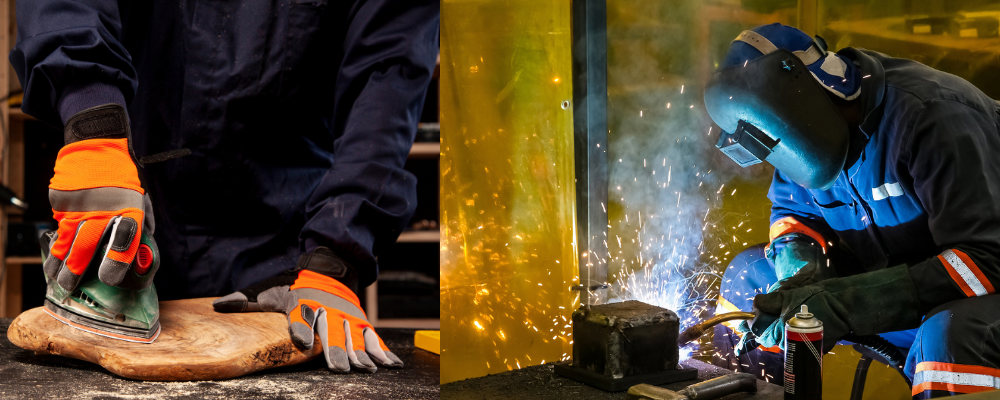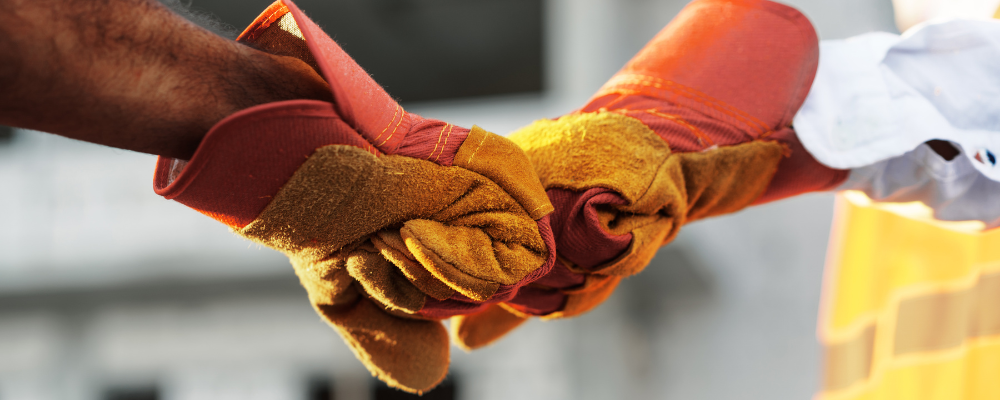
Introduction
Construction sites are inherently hazardous environments, demanding utmost attention to safety protocols. Among the crucial safety measures, hand protection stands as a paramount concern. In this comprehensive guide, we will discuss the significance of hand protection for construction workers, explore the technical aspects, and introduce essential products to ensure a secure working environment.
Why Hand Protection Matters in Construction
In the dynamic and often hazardous environment of construction sites, the importance of hand protection cannot be overstated. The nature of construction tasks exposes workers to an array of risks that constantly threaten their well-being. Understanding these risks is fundamental to appreciating the critical role that effective hand protection plays in the construction industry.
Construction Tasks and Associated Risks
Construction workers engage in many tasks, each carrying its hazards. Among the most prevalent risks are:
- Abrasions: The abrasive nature of construction materials, such as concrete, metal, and wood, makes workers susceptible to skin abrasions. Unprotected hands are vulnerable to scratches and abrasions, which, though seemingly minor, can lead to infections and prolonged discomfort.
- Cuts: Sharp tools, machinery, and jagged materials are omnipresent on construction sites, posing a constant risk of cuts and lacerations. Without adequate hand protection, workers face the potential of severe injuries that can impede their ability to work and compromise overall project timelines.
- Chemical Exposures: Construction often involves various chemicals, from adhesives to solvents. Prolonged or direct exposure to these substances without proper hand protection can result in chemical burns, dermatitis, and other adverse health effects.
Crucial Role of Effective Hand Protection
Mitigating Risks and Preventing Injuries
Adequate hand protection serves as a formidable barrier against these inherent risks. By providing a layer of defense, gloves, and other hand protection measures act as a first line of defense, mitigating the impact of abrasions, preventing cuts, and shielding against harmful chemicals. It not only safeguards the physical well-being of workers but also contributes to maintaining optimal productivity levels.
Enhancing Worker Well-being
Beyond the immediate physical risks, the psychological impact of sustained injuries cannot be ignored. Hand injuries can lead to long-term discomfort, reduced job satisfaction, and even the development of chronic conditions. Through comprehensive hand protection measures, construction workers can confidently carry out their duties, knowing that their safety is prioritized.
Compliance with Safety Standards
In the construction industry, adherence to safety standards is not merely a best practice but a non-negotiable imperative. Hand injuries are unfortunately commonplace, and failing to address these risks adequately can have far-reaching consequences for the workforce and the construction project.
Addressing the Commonality of Hand Injuries
Hand injuries account for many workplace incidents in the construction sector. Whether resulting from a momentary lapse in attention, an unexpected equipment malfunction, or an oversight in the handling of materials, these injuries can lead to physical harm and project delays, increased costs, and potential legal ramifications.
Achieving Adherence to Safety Standards
Implementing suitable hand protection measures is a cornerstone of achieving and maintaining compliance with safety standards. By incorporating gloves designed to withstand the specific hazards encountered on construction sites, employers demonstrate a commitment to the well-being of their workforce and a dedication to upholding industry regulations.
Reducing Accidents and Legal Repercussions
The financial and legal ramifications of workplace accidents are substantial. Injuries resulting from a lack of hand protection not only lead to direct medical and rehabilitation costs but can also result in legal liabilities. Adhering to safety standards by providing appropriate hand protection significantly reduces the likelihood of accidents, mitigating legal repercussions and fostering a safer working environment.
In summary, recognizing the risks inherent in construction tasks and understanding the pivotal role of hand protection is foundational to promoting a culture of safety on construction sites. By prioritizing effective hand protection measures, the construction industry not only safeguards the physical well-being of its workforce but also fortifies its adherence to safety standards, thereby contributing to a safer, more productive work environment.

Technical Aspects of Hand Protection
-
4189-OFTP: Optimizing Hand Protection Technology
Introducing the 4189-OFTP, a cutting-edge hand protection solution designed to meet the rigorous demands of construction work. This innovative product boasts advanced materials engineered to resist abrasions and punctures while providing dexterity crucial for intricate tasks.
-
Welding Gloves: Ensuring Safety in High-Risk Environments
For welding tasks, the 4202 Welding Gloves emerge as an indispensable choice. Crafted from fire-resistant materials, these gloves provide superior protection against burns and heat, ensuring the safety of construction workers engaged in welding operations.
-
DermiFlex Safety Gloves Black: Balancing Comfort and Protection
Comfort is paramount without compromising safety. DermiFlex Safety Gloves Black offer a perfect blend of comfort and protection. The ergonomic design and breathable materials make them ideal for prolonged use without sacrificing hand safety.
-
Dexti-Grip Glove: Precision in Construction Work
Precision is key in many construction tasks. The Dexti-Grip Glove is engineered to provide excellent grip and tactile sensitivity, enabling construction workers to handle intricate tools and materials confidently.
Choosing the Right Hand Protection
Ensuring the safety of construction workers requires a nuanced understanding of the diverse daily tasks. Hand protection, a critical facet of this safety framework, demands a strategic approach. This section delves into the intricacies of choosing the right-hand escort, emphasizing the need to assess task-specific risks and prioritize comfort and fit.
-
Assessing Task-Specific Risks
-
Tailoring Hand Protection to Task Requirements
Construction tasks are multifaceted, each presenting unique challenges and risks to the hands of workers. For instance, tasks involving sharp objects may necessitate gloves with puncture-resistant materials, while those involving chemicals may require gloves with appropriate chemical resistance. By conducting a thorough risk assessment for each task, employers can identify the specific hazards and select hand protection products that offer targeted defense.
-
Categorizing Risks: A Prerequisite for Selection
Not all risks are created equal, and it is essential to categorize them based on severity and frequency. High-risk tasks, such as metal fabrication or welding, demand specialized gloves to withstand extreme conditions. On the other hand, tasks involving repetitive motions may require gloves with ergonomic designs to prevent musculoskeletal strain.
-
Matching Hand Protection to Task Complexity
Tasks involving intricate hand movements, such as handling small tools or assembling components, require precision and flexibility gloves. Choosing materials and glove design becomes crucial in these scenarios, ensuring the hand protection solution does not hinder dexterity.
-
Prioritizing Comfort and Fit
-
The Ergonomics of Hand Protection
Protective gloves should shield hands from hazards and ensure comfort and a proper fit. Ill-fitting gloves can compromise dexterity, decreasing productivity and possible discomfort for the wearer. Prioritizing ergonomics in glove design is paramount, as it enhances the overall experience of the worker and encourages consistent usage.
-
The Impact of Discomfort on Productivity
Uncomfortable gloves can lead to distractions, irritation, and reduced focus, affecting the quality of work performed. It, in turn, can compromise the safety of the workers and those around them. Investing in gloves that strike the right balance between protection and comfort is an investment in the workforce’s physical well-being and productivity.
-
Inclusive Considerations for Diverse Workforces
Recognizing the diverse nature of construction workforces is crucial when selecting hand protection. Different individuals may have varying hand sizes and preferences. Employers should consider providing a range of sizes and styles to accommodate the unique needs of their workforce, ensuring that everyone has access to adequate and comfortable hand protection.
In construction safety, choosing the right-hand protection is not a one-size-fits-all endeavor. It requires a meticulous examination of task-specific risks and a commitment to prioritizing protection and comfort. By tailoring hand protection solutions to the intricacies of construction tasks and embracing ergonomic designs, employers can foster a safer and more productive work environment for their valuable workforce. Remember, suitable gloves are not just a safety measure but an investment in the well-being and efficiency of those who build our world.
For more information, visit our website and Facebook page.
And for more products,
Conclusion
In conclusion, prioritizing hand protection is not just a regulatory requirement; it is an investment in the well-being and productivity of construction workers. The 4189-OFTP, 4202 Welding Gloves, DermiFlex Safety Gloves Black, and Dexti-Grip Glove are exemplary choices, showcasing the pinnacle of hand protection technology. Construction sites can significantly enhance safety standards by understanding the technical aspects and choosing the right-hand protection for specific tasks, ensuring a secure working environment.
Remember, a well-protected workforce is a productive workforce. Invest in hand protection today and build a safer tomorrow for your construction team.










